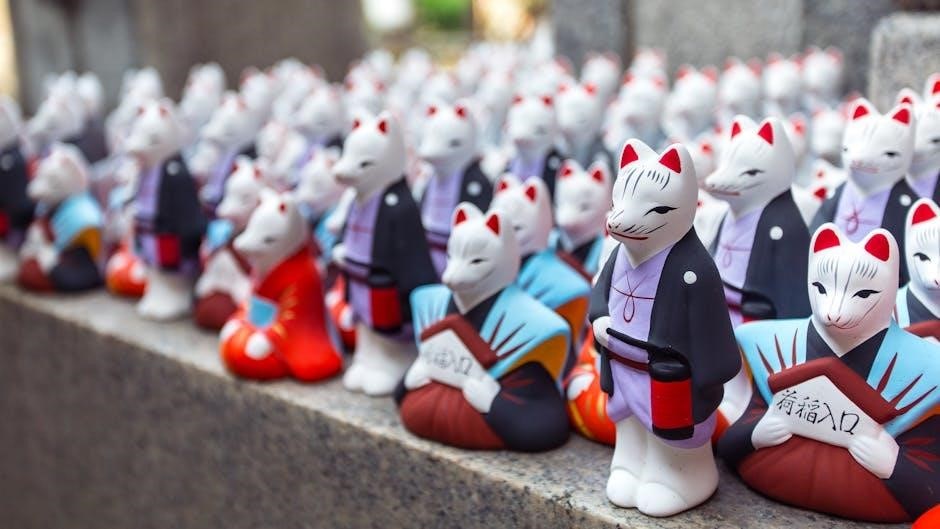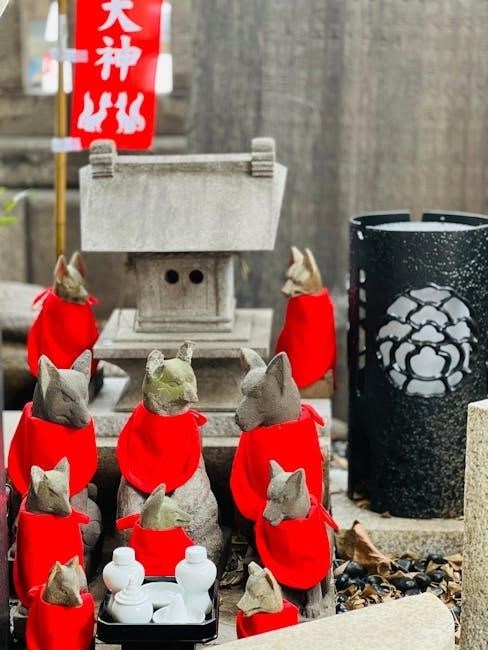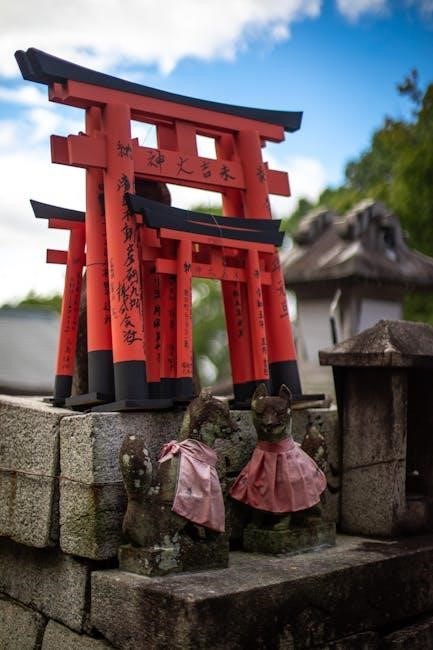Fox Spirit Guide: Exploring the Myth and Lore

Delve into the captivating world of fox spirits, figures prominent in East Asian folklore and mythology. These supernatural entities, known by various names like Huli Jing and Kitsune, possess unique abilities and diverse representations across different cultures.
Fox spirits, enigmatic figures woven into the fabric of East Asian mythology, represent more than just cunning animals. They are supernatural beings, often capable of shapeshifting and wielding magical powers. Known as Huli Jing in China, Kitsune in Japan, and Kumiho in Korea, these entities blur the lines between the natural and supernatural realms.
These spirits are not merely tricksters; they embody a complex duality. Some are benevolent guardians, offering guidance and protection, while others are mischievous pranksters, causing chaos and testing human morality. Their origins are rooted in ancient folklore, where foxes, through age and accumulation of spiritual energy, gain extraordinary abilities.
The fox spirit’s association with Yin energy, often linked to femininity and mystique, further contributes to their allure. Depicted as alluring women, they test the boundaries of desire and challenge societal norms. Understanding fox spirits requires exploring their multifaceted roles in mythology, from divine messengers to seductive temptresses, shaping cultural beliefs and artistic expressions.
Fox Spirits in Mythology
Fox spirits occupy a prominent space in mythology, intertwining with deities, heroes, and supernatural beings across various cultures. In Chinese mythology, Huli Jing play diverse roles, acting as advisors to emperors or seductresses leading to ruin. Their presence is a constant reminder of the balance between good and evil, virtue and vice.
Japanese mythology features Kitsune as shapeshifting spirits, often associated with Inari, the god of rice and prosperity. These foxes can possess great wisdom and magical abilities, sometimes serving as messengers or guardians. Their tails signify their age and power, with nine-tailed foxes representing the pinnacle of spiritual attainment.
Korean mythology presents Kumiho, nine-tailed foxes seeking to become human. Their stories often involve themes of transformation, desire, and the challenges of bridging the gap between the spirit world and the human realm. While some Kumiho are portrayed as malevolent, others strive for genuine connection and redemption.
These mythological portrayals showcase the enduring fascination with fox spirits, their complex nature reflecting humanity’s own struggles and aspirations.

East Asian Fox Spirits
East Asian folklore teems with tales of fox spirits, supernatural entities deeply woven into the cultural fabric. These beings, known as Huli Jing, Kitsune, and Kumiho, each possess unique traits and roles within their respective mythologies.

Huli Jing (Chinese Fox Spirit)
In Chinese mythology, the Huli Jing, or fox spirit, holds a significant place, often depicted as a creature capable of shapeshifting and wielding magical powers. These spirits, found throughout Chinese folklore and literature, can be either benevolent or malevolent, serving as advisors, seducers, or mischievous tricksters, their presence adding layers of complexity to the narratives they inhabit.
Huli Jing are believed to attain their powers through encounters with the universe, absorbing magic aura that enables them to transform into human form and even achieve immortality. The portrayal of Huli Jing often reflects a duality, embodying both cunning and virtuous qualities, captivating and sometimes causing problems for those who cross their paths. They are frequently associated with an excess of yin energy, leading to their common depiction as alluring women who can bewitch and lure men.
These fox spirits play a prominent role in Chinese mythology, intertwining with various deities, heroes, and supernatural beings, enriching the tapestry of Chinese folklore with their enchanting and often enigmatic presence. Their stories explore themes of transformation, adaptability, and the blurred lines between the human and spirit realms.

Powers and Abilities of Huli Jing
Huli Jing, the fox spirits of Chinese mythology, are renowned for their diverse array of supernatural powers and abilities. At the forefront of their capabilities is shapeshifting, allowing them to seamlessly transform into human beings, often taking the form of beautiful women to interact with the mortal realm. This ability is central to many tales, where they might seduce, trick, or assist humans, depending on their nature.
Beyond mere physical transformation, Huli Jing possess magical powers derived from their accumulation of spiritual energy. These powers can include illusion casting, creating convincing mirages to deceive others, and manipulation of the elements to influence their surroundings. Some Huli Jing are also said to have the ability to possess humans, taking control of their bodies and actions for their own purposes.

Immortality is another coveted ability often associated with Huli Jing, achieved through centuries of cultivation and magical practice. As they grow older and more powerful, their abilities intensify, solidifying their status as formidable beings within Chinese folklore. The extent and application of these powers vary depending on the individual spirit and the specific narratives in which they appear.
Huli Jing as Benevolent or Malevolent Spirits
The Huli Jing of Chinese mythology are not monolithic entities; their nature and intentions span a wide spectrum, ranging from benevolent guardians to malevolent tricksters. In some tales, Huli Jing appear as wise advisors, offering guidance and assistance to humans, using their magical abilities for the benefit of those they deem worthy. These benevolent spirits may protect families, bring prosperity, or even impart knowledge of the mystical arts.
Conversely, other stories depict Huli Jing as mischievous or even dangerous beings. These malevolent spirits often use their shapeshifting abilities to deceive and seduce humans, leading them astray or causing them harm. They may manipulate events for their own amusement, reveling in chaos and disruption. Tales of seduction, betrayal, and misfortune often accompany the presence of these darker Huli Jing.
Ultimately, the portrayal of Huli Jing reflects a duality inherent in many mythological figures, embodying both the potential for good and the capacity for evil. The specific context of each story shapes the spirit’s character, highlighting the complex relationship between humans and the supernatural world.
Kitsune (Japanese Fox Spirit)
In Japanese folklore, the Kitsune, meaning “fox,” transcends its literal definition to represent a supernatural entity with remarkable abilities. These mythical foxes are a type of Yokai, supernatural creatures possessing godlike powers, deeply embedded in Japanese culture and spirituality. Revered and sometimes feared, Kitsune are known for their intelligence, long lifespans, and potent magical prowess, most notably shapeshifting.
Kitsune are often portrayed as tricksters, using their shapeshifting abilities to play pranks on humans, but they can also be loyal guardians, wise advisors, and devoted companions. Their motivations are complex and varied, reflecting the multifaceted nature of these spirits. Some Kitsune are said to serve the Shinto deity Inari, acting as messengers and protectors of rice fields and prosperity.
Their supernatural abilities grow with age and wisdom, and a key indicator of their power is the number of tails they possess, ranging from one to nine. The nine-tailed fox, or Kyubi no Kitsune, is considered the most powerful and enlightened of its kind.
Kitsune’s Shapeshifting Abilities
One of the most defining characteristics of the Kitsune is their extraordinary ability to shapeshift, allowing them to transform into various forms, most commonly humans. This power is not merely a disguise; it’s a complete alteration of their physical appearance, enabling them to seamlessly integrate into human society. Kitsune often assume the forms of beautiful women or handsome men to seduce, trick, or even assist humans, depending on their individual nature and intentions.
The shapeshifting abilities of Kitsune are closely tied to their age, wisdom, and magical power. As they grow older and accumulate experience, their transformations become more convincing and easier to maintain. A young Kitsune might struggle to perfectly conceal its fox-like features, such as a tail or pointed ears, while an older, more powerful Kitsune can flawlessly mimic human appearance.
This ability underscores themes of transformation and adaptability, reflecting the Kitsune’s cunning and resourcefulness in navigating the human world. The Kitsune’s shapeshifting is not limited to humans, as they can also transform into other animals or even inanimate objects, further showcasing their versatile and enigmatic nature.
The Significance of Tails in Kitsune Lore
In Kitsune lore, the number of tails a Kitsune possesses is a direct indication of its age, wisdom, and magical power. A young Kitsune begins with a single tail, and as it grows older and accumulates knowledge, it gains additional tails. The most powerful and revered Kitsune are those with nine tails, known as Kyūbi no Kitsune. These nine-tailed foxes are considered ancient and incredibly potent beings, often possessing near-divine status.
The tails of a Kitsune are not merely decorative; they are conduits for its magical energy. Each tail represents a significant increase in the Kitsune’s power and abilities, granting it greater control over illusions, shapeshifting, and other supernatural feats. The presence of multiple tails also signifies a Kitsune’s accumulated wisdom and experience, reflecting its long life and mastery of the arcane arts.

Losing a tail is a grave matter for a Kitsune, as it represents a significant loss of power and status. It is a rare occurrence, typically resulting from a severe injury or a profound spiritual setback. The nine-tailed Kitsune are virtually invincible, making the loss of even a single tail an almost unimaginable event, further emphasizing their unparalleled power and importance in Japanese folklore.

Fox Spirits in Different Cultures
Fox spirits manifest uniquely across cultures. From the Korean Kumiho to their role in Taoism, their characteristics vary. They are often portrayed as tricksters, seducers, or benevolent guardians, reflecting diverse cultural beliefs and interpretations.
Korean Kumiho
The Kumiho, a nine-tailed fox spirit in Korean mythology, shares similarities with its counterparts in Chinese and Japanese folklore. Unlike some benevolent depictions, the Kumiho is often portrayed as a dangerous and malevolent figure, primarily preying on humans to sustain its existence or achieve full human form. Legends depict the Kumiho as capable of shapeshifting, frequently appearing as a beautiful woman to seduce and devour unsuspecting men, consuming their livers or hearts.
The transformation into a human is a central theme in Kumiho narratives, with the spirit undergoing a prolonged process that requires abstaining from killing and consuming human flesh for a thousand days. Some tales suggest that the Kumiho can only become fully human by consuming a hundred human livers, highlighting the creature’s inherent predatory nature and the moral challenges it faces. Despite the prevalent negative portrayals, some stories present a Kumiho striving for genuine humanity, grappling with inner conflict and the desire to escape its cursed existence. This duality adds depth to the Kumiho’s character, exploring themes of redemption and the blurred lines between good and evil within the realm of Korean folklore.
Fox Spirits in Taoism
In Taoism, fox spirits, known as Huxian (狐仙), occupy a unique position, often revered as deities or spiritual entities with the potential for both benevolent and malevolent actions. Unlike purely demonic portrayals, Taoist beliefs recognize the capacity of foxes to cultivate spiritual power through longevity and dedicated practice. Foxes are believed to accumulate qi, the vital life force, and enhance their magical abilities over centuries, eventually attaining the status of celestial beings.
Taoist temples are sometimes dedicated to Huxian, where devotees offer prayers and seek blessings for wealth, love, and protection. These fox spirit deities are viewed as intermediaries between the human and spiritual realms, capable of influencing earthly affairs. However, the relationship between humans and Huxian is not always harmonious. Taoist teachings acknowledge the cunning and potentially mischievous nature of fox spirits, cautioning against excessive reliance on their powers. The integration of fox spirits into Taoism reflects the religion’s adaptability and its embrace of diverse spiritual forces, recognizing the inherent duality within nature and the potential for transformation. The worship of Huxian highlights the complex interplay between humans and the supernatural in Taoist cosmology.

Fox Spirits: Symbolism and Interpretation
Fox spirits symbolize duality, cunning, and transformation across cultures. They embody adaptability, intelligence, and the allure of the unknown. Their association with yin energy further emphasizes their enigmatic and multifaceted nature within mythology and folklore.
Fox Spirits as Symbols of Cunning and Adaptability
Fox spirits, across diverse mythologies, frequently symbolize cunning and adaptability. This symbolism stems from the fox’s natural traits, observed in their behavior and translated into the supernatural realm. Their reputation for cleverness and resourcefulness makes them potent figures embodying intelligence and strategic thinking.
In Chinese mythology, the Huli Jing exemplifies this, navigating complex social structures with wit and charm, often depicted as advisors or tricksters using their intellect to achieve their goals. Similarly, the Japanese Kitsune utilizes their shapeshifting abilities not only for deception but also to adapt to different situations, highlighting their capacity to thrive in changing circumstances.
The fox’s ability to seamlessly blend into their environment further reinforces this symbolism. Their adaptability reflects a deep understanding of their surroundings, allowing them to anticipate challenges and seize opportunities with agility. This makes them powerful symbols of resilience and the ability to overcome obstacles through intellect and flexibility.
Fox Spirits and Yin Energy
Fox spirits are frequently associated with yin energy, a concept deeply rooted in Taoist philosophy and East Asian cosmology. Yin represents the feminine principle, characterized by qualities like passivity, intuition, and the moon. This association often leads to fox spirits being depicted as female figures, embodying allure and mystique.
The connection with yin energy also implies a link to the spiritual realm, as yin is often associated with the unseen and the subconscious. This reinforces the fox spirit’s image as a magical being, capable of interacting with realms beyond human perception. Their powers of illusion and shapeshifting can be interpreted as manifestations of this connection to yin energy, allowing them to manipulate reality in subtle ways.
Furthermore, the fox spirit’s association with yin energy contributes to their complex and often ambiguous nature. While yin is not inherently negative, it can be associated with deception and the unknown, adding to the fox spirit’s reputation as a trickster figure. This duality makes them fascinating symbols of the interplay between light and shadow, and the balance between opposing forces.

Fox Spirit Altars
Fox spirit altars, though perhaps less widely known than those dedicated to other deities, represent a tangible connection to these mystical beings. These altars, often found in Taoist temples or private homes, serve as focal points for veneration and offerings. The presence of a fox spirit altar signifies a belief in the fox spirit’s power to grant blessings, protection, or assistance in various endeavors.
These altars typically feature images or representations of fox spirits, such as statues, paintings, or inscribed tablets. Offerings of food, incense, and symbolic objects are commonly placed on the altar to honor the fox spirit and seek its favor. The specific rituals and customs associated with fox spirit altars can vary depending on local traditions and individual beliefs.
Some believe that fox spirits, especially those revered as benevolent deities, can bring prosperity, good fortune, and harmonious relationships. Others may seek the fox spirit’s guidance in matters of love, career, or personal growth. Regardless of the specific intention, fox spirit altars represent a unique and intriguing aspect of East Asian spiritual practices.
